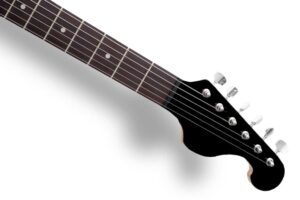 If your child is learning the guitar, one thing they will want to master early on is the different parts of the guitar. In fact, this will probably be a lesson in one of their first at-home guitar lessons.
If your child is learning the guitar, one thing they will want to master early on is the different parts of the guitar. In fact, this will probably be a lesson in one of their first at-home guitar lessons.
If you want to help your young player get ahead of the game, before even meeting with their guitar teacher, you can start teaching them the parts of the guitar now. Here’s a run-down of the basic parts you’ll find on every guitar.
The Body
The body is the largest part of the guitar. It’s where all of the other parts connect. Generally, the body is rounded on one end and features curves to help it sit on the leg or be held in the player’s arms.
The body may be solid wood, or it could have a hollow body. If your child is learning on an electric guitar, all of the electronics are held within a cavity in the body.
Guitar bodies can be made from the same wood on all sides, top, and back, or different woods can be used. The body has a number of different items on it, such as the bridge and the tailpiece.
The Tailpiece
The tailpiece is usually the last item on the body and is located on the far opposite end of the guitar from the headstock. This is where the strings are attached. Some guitars merge the tailpiece into the bridge, creating one unit.
The Bridge
The bridge is located in front of the tailpiece and holds the strings up away from the rest of the guitar. On acoustic guitars that don’t have a tailpiece, the bridge has small pins at the back that anchor the strings.
The Pickups
The pickups are found in front of the bridge before the neck. They’re basically magnets that have been wrapped up in wire and make a magnetic field under the strings. This sends the sound from the strings to the amplifier and speaker. Only electric guitars have pickups.
The Sound Hole
Acoustic guitars have a hole in the body that helps equalize the pressure from within the body created by the vibrations from the strings.
Pickguard
The pickguard helps protect the wooden part of your guitar from being scratched by the pick. Some electric guitars do not have pickguards.
Volume and Tone Knobs
The volume and tone knobs on an electric guitar control the overall volume and the amount of treble. Some guitars have multiple tone knobs, while others may just have one.
The Neck
The neck of the guitar is the part that juts out from the body. This is where the strings are located. At the opposite end is the headstock, the part that anchors the strings and allows for tuning them. The fretboard is found on the front side of the neck. Like the body, there are several parts on the neck.
The Fretboard
The fretboard runs the entire length of the neck and holds the strings. Players press on the fretboard to create notes. The fretboard contains the frets, or the metal strips that run across the board. Pressing in at a fret shortens the string, changing the pitch.
The Nut
The nut sits between the end of the fretboard and the headstock. It holds the strings and makes it easier to tune the guitar.
The Headstock
The headstock is the third and final piece of the guitar. It sits at the end of the neck. The strings are attached at the headstock, and it’s where the tuning pegs are located.
The Tuning Pegs
The tuning pegs are the main feature of the headstock. Each tuning peg is connected to a string. When the player turns the tuner, the string either becomes tighter or looser. This changes its pitch.
Want to Learn More About Lessons?
If your little one wants to play the guitar, there’s nothing better than having their first guitar lesson conducted right in your own home. Contact us today to discuss how your child can start learning the guitar today.
